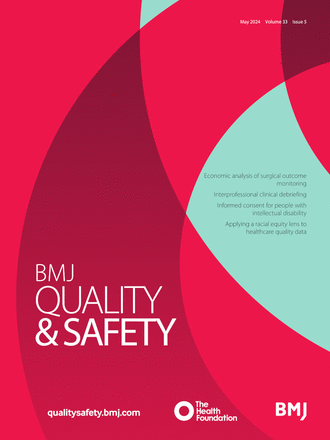儿科用药事故报告:一项多中心比较研究,内容涉及审计中发现的用药错误、员工发现的用药错误以及向事故系统报告的用药错误
IF 5.6
1区 医学
Q1 HEALTH CARE SCIENCES & SERVICES
引用次数: 0
摘要
目的 比较儿科医院通过审计和直接观察发现的用药错误与向事故报告系统报告的用药错误,并调查员工发现和报告的错误类型和严重程度的差异。方法 这是 2016 年至 2020 年期间在澳大利亚两家三级转诊儿科医院进行的一项比较研究。通过对 7785 份病历进行用药图表审核,确定了处方错误。通过对 1530 名患者的 5137 次用药剂量进行前瞻性直接观察研究,确定了用药错误。对医院事故报告系统中报告的用药错误进行了识别,并与审计和观察中发现的错误进行了比对。结果 在审计发现的 11 302 个临床处方错误中,每 1000 个错误中有 3.2 个(95% CI 2.3 至 4.4,n=36)有事故报告。在审计发现的 2224 个潜在严重处方错误中,有 26.1%(95% CI 24.3 至 27.9,n=580)被员工发现,每 1000 个错误中有 11.2 个(95% CI 7.6 至 16.5,n=25)向事故系统报告。虽然两家医院的处方错误发现率不同,但无论错误严重程度如何,事故报告率却没有差异。在 40 个对患者造成实际伤害的错误中,只有 7 个(17.5%;95% CI 8.7% 至 31.9%)被员工发现,4 个(10.0%;95% CI 4.0% 至 23.1%)有事故报告。在观察到的 2883 次临床用药错误中,包括 903 次潜在的严重错误和 144 次对患者造成实际伤害的错误,没有一次有事故报告。结论 事故报告数据不能准确反映医院中的用药错误及对儿童造成的相关伤害。未能发现用药错误很可能是导致错误报告率低的重要原因。在电子病历时代,应采用新的自动化方法对用药安全进行实时监控。无数据可用。本研究使用了患者的个人健康数据,这些数据未经伦理批准不得共享。这也排除了共享汇总数据集的可能性。分析数据集根据伦理批准进行存储,只有获得伦理委员会批准的研究人员才能访问。本文章由计算机程序翻译,如有差异,请以英文原文为准。
Paediatric medication incident reporting: a multicentre comparison study of medication errors identified at audit, detected by staff and reported to an incident system
Objectives To compare medication errors identified at audit and via direct observation with medication errors reported to an incident reporting system at paediatric hospitals and to investigate differences in types and severity of errors detected and reported by staff. Methods This is a comparison study at two tertiary referral paediatric hospitals between 2016 and 2020 in Australia. Prescribing errors were identified from a medication chart audit of 7785 patient records. Medication administration errors were identified from a prospective direct observational study of 5137 medication administration doses to 1530 patients. Medication errors reported to the hospitals’ incident reporting system were identified and matched with errors identified at audit and observation. Results Of 11 302 clinical prescribing errors identified at audit, 3.2 per 1000 errors (95% CI 2.3 to 4.4, n=36) had an incident report. Of 2224 potentially serious prescribing errors from audit, 26.1% (95% CI 24.3 to 27.9, n=580) were detected by staff and 11.2 per 1000 errors (95% CI 7.6 to 16.5, n=25) were reported to the incident system. Although the prescribing error detection rates varied between the two hospitals, there was no difference in incident reporting rates regardless of error severity. Of 40 errors associated with actual patient harm, only 7 (17.5%; 95% CI 8.7% to 31.9%) were detected by staff and 4 (10.0%; 95% CI 4.0% to 23.1%) had an incident report. None of the 2883 clinical medication administration errors observed, including 903 potentially serious errors and 144 errors associated with actual patient harm, had incident reports. Conclusion Incident reporting data do not provide an accurate reflection of medication errors and related harm to children in hospitals. Failure to detect medication errors is likely to be a significant contributor to low error reporting rates. In an era of electronic health records, new automated approaches to monitor medication safety should be pursued to provide real-time monitoring. No data are available. This study used individual patient health data that cannot be shared without ethical approval. This also precludes the sharing of aggregated data sets. Analysis data sets are stored according to the ethical approval and access can only be provided to researchers who have received approval from the ethics committee.
求助全文
通过发布文献求助,成功后即可免费获取论文全文。
去求助
来源期刊

BMJ Quality & Safety
HEALTH CARE SCIENCES & SERVICES-
CiteScore
9.80
自引率
7.40%
发文量
104
审稿时长
4-8 weeks
期刊介绍:
BMJ Quality & Safety (previously Quality & Safety in Health Care) is an international peer review publication providing research, opinions, debates and reviews for academics, clinicians and healthcare managers focused on the quality and safety of health care and the science of improvement.
The journal receives approximately 1000 manuscripts a year and has an acceptance rate for original research of 12%. Time from submission to first decision averages 22 days and accepted articles are typically published online within 20 days. Its current impact factor is 3.281.
 求助内容:
求助内容: 应助结果提醒方式:
应助结果提醒方式:


